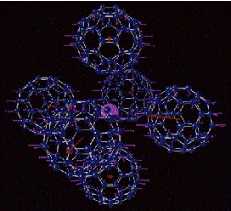It’s not uncommon for undergraduate students publish their research in professional peer-reviewed scientific journals. NSF and NIH-funded researchers can apply for additional funds to support undergraduates in their labs. In addition, the department awards students from the A. Crowell Fund support in undergraduate research in physics.
Computational Biophysics
We use molecular simulations to understand the physical principles underlying the function of biological systems. This is pertinent to lipid biomembranes, mechanosenstive channels, and enzymatic catalysis. We study the connection between chemical structure and mechanical properties at the nanoscale. Researchers in our group contribute to the development and implementation of local stress calculations from molecular dynamic simulations. If interested, please contact Professor Juan Vanegas at Juan.Vanegas@uvm.edu
Optoelectronic Devices
Our research efforts focus on materials for optoelectronic devices like solar cells and LEDs. We are exploring low-cost and high-efficiency solar cell materials. We aim to construct electroluminescent devices with resonant cavities at visible wavelengths If you want to join us in exploring the world of materials and device physics at UVM, contact Professor Matthew White at Mathew.White.1@uvm.edu
 Theoretical Physics
Theoretical Physics
(Image at left: Vibrating cluster of C60 molecules with a Potassium atom). For undergraduates who have completed some of the 200-level course work in physics, there are opportunities to pursue research projects in theoretical physics under faculty supervision. Theoretical projects typically involve using mathematical techniques to study the behavior of a model system. To make quantitative connections to experimental data, we often use computers available on campus to numerically study a specific system. Many projects involve one or more of the following branches of physics: atomic and molecular physics, condensed matter physics, quantum physics, surface physics, chemical physics, and statistical physics. Projects frequently relate to developing an understanding of the properties of molecules, clusters, and solids, starting from a foundation of quantum mechanics. Such studies contribute to the emerging field of nanoscience, the science of systems whose spatial extent is of the order of nanometers! Future undergraduate research projects include investigating new ways of making a quantum computer, exploring how biopolymers like DNA stick to surfaces, and studying the nature of the van der Waals interaction. (That may be what enables the gecko to walk on walls!) More details can be found on Professor Clougherty’s web site.
Ultrasonics and Optics
These projects usually involve (but are not limited to) applications of ultrasound and light. Recent student research projects include: Nonlinear behaviors of bubbles, delivery of drugs and DNA on target, acoustic imaging and optical trapping. Students interested in this area can contact Professor Junru Wu via junru-wu@uvm.edu.


